Rubber trees have existed on the red basalt land of Phu Quy in Nghe An since French colonial times. At that time, there was a Phu Quy rubber plantation here, but the area was less than 1,000 ha. After peace was restored, especially since the 1960s, the rubber trees in the Phu Quy area have grown to nearly 9,000 ha, concentrated in Nghia Dan, Thai Hoa, Quy Hop and Quy Hop districts. Tan Ky in which the most is Nghia Dan with over 2,500 ha.
Phu Quy basalt red land covers an area of about 12,400 hectares, which is very suitable for growing fruit trees, perennial industrial crops such as rubber, coffee, orange, tea… Especially for rubber trees in recent years, fall fairly stable income for people in mountainous areas. But in recent years, rubber trees have been on the ups and downs, with many areas cut down to switch to other trees.
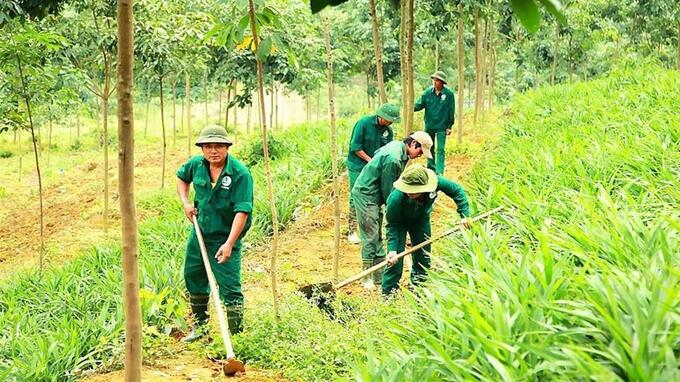
Rubber used to be a crop that brought warmth to the people of the mountainous Nghe An region.
Many areas have been cleared
Ms. Nguyen Thi Hang in Nghia Hong Township, Nghia Dan District, started cutting down nearly 0.6 ha of rubber trees during the latex exploitation period. When asked why she had to cut down such beautiful rubber trees, Ms. Hang sighed and said, “Maybe my rubber garden must be of poor quality, but scraping the entire garden of almost 0.6 ha can also yield only 35-40 kg of pus little .
Although the yield of latex was not high, a few years ago it was still sold for 7,000-8,000 VND/kg of latex, then the latex price gradually dropped and now it can only be sold for 4,000-5,000 VND/kg. The whole rubber garden earns only VND 200,000 per day, the income is not enough to pay for the working day, let alone other expenses. After I cut down all the rubber trees, my family will switch to growing guava, which is both easy to grow and is currently a high-yielding tree in the area.”
Mr. Ho Sy Minh, Vice Chairman of Nghia Hong Municipality People’s Committee, said: Nghia Hong is the municipality that grows the most rubber trees in Nghia Dan District. In 2007-2009, the price of rubber latex was 14,000-15,000 VND/kg, and the acreage was massively expanded to almost 700ha.
In the current market mechanism, it is normal for prices to rise and fall. However, there was a time when the purchase price was only 4,000-5,000 VND/kg, discouraging growers. In the past two years, the price of rubber latex has increased to VND 7,000-8,000/kg. But at this price, growers are still not profitable because the cost of harvest and input material is too high, while the yield of latex is also low, so many households have cut down their rubber plantations to switch to fruit trees of all kinds with higher yields expect.
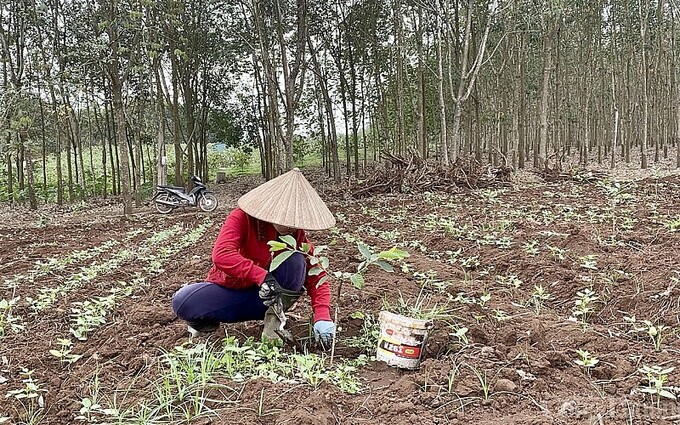
Many families in Nghia Hong Township (Nghia Dan District) destroyed their rubber garden and switched to cultivating guava. Picture: Phu Huong.
Therefore, Nghia Hong Township’s rubber area of nearly 700 hectares is now only 337 hectares left. According to Mr. Ho Sy Minh, the current cutting down of many rubber trees to switch to other responsible trees has not really accompanied growers to instruct and guide them to do this…so that rubber trees have a high latex yield, leading the producers to a better income helps …
The most typical example is Ms. Dinh Thi Lan’s family in Hong Truong Hamlet (Nghia Hong Municipality) almost 10 years ago when 0.5 ha of oranges were converted into rubber trees and the first batch of rubber was harvested in June 2022. “The period of latex cone lasts only 6 months, the yield is too small, the 0.5 ha area can only collect 7-8 kg of latex every day, the quality of the latex is poor, so the selling price is only 5,000 – 6,000 VND/kg, even selling only 3,000-4,000 VND/kg some days, it’s really not worth shaving the latex since it’s not morning yet,” Lan said.
Facing the situation that many rubber plantations are at risk of being cut down to shift land to other trees, Le Dai Nhan, deputy director of Co Do Farm, said the farm currently has 646 hectares of land, of which nearly 300 hectares are high .su. Some orchards have low latex yield and low income. If people want to destroy them in order to switch to fruit trees, the farm will create favorable conditions.

Rubber trees were once likened to “white gold” but are now being cut down to be used for other crops. Picture: Phu Huong.
The situation of people cutting down rubber trees to plant fruit trees such as guava, tangerine, etc. is happening every day in the Phu Quy area and has not ended yet. According to a report by the Nghia Dan Ministry of Agriculture and Rural Development, as of 2020 alone, the area of rubber trees in the district of 1,500 hectares will be only about 900 hectares.
Not only Nghia Dan district, other places like Thai Hoa town, Quy Hop district, Tan Ky district… similar happened.
What is the solution to the current gum tree?
Regardless of the ups and downs, the rubber tree is still considered “white gold”, it is considered one of the four most important raw materials of industry (coal, iron and steel, petroleum, rubber). . The rubber tree not only brought income to the people of the mountainous region of Nghe An in the past, but is also a tree that contributes very well to soil protection, erosion control and climate change. , create a good ecological environment…
Rubber trees have to be liquidated after many years of economic exploitation, the rubber tree wood also gives a high value and is today considered a primary material for industry and crafts in the manufacture of wooden products such as plywood, tables, chairs, household appliances. .
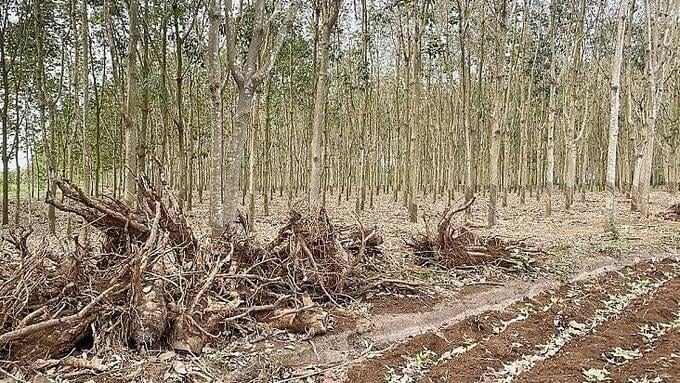
The people of Nghia Dan destroy rubber trees to grow short-term trees. Picture: Phu Huong.
In recent years, many rubber plantations have been cut down for many reasons. From there, local leaders, businesses and rubber growers must learn lessons from experience to continue the development of rubber trees in Phu Quy’s red basalt land to create more values today and tomorrow. Special:
One: According to the plan of Nghe An province, which aims to 2025, the whole province has 17,000 ha of rubber. To achieve this goal, in addition to the leadership and drastic control of the provincial Party Committee, the provincial People’s Committee and the heads of the municipalities, the government department, the Ministry of Agriculture and Rural Development must have a clear and concrete plan for what kind of land, where, how large the area, how long the planting time and how large the planting area each year, so that by 2025 it will be 17,000 hectares as planned.
If there is no specific planning, it is very easy to have a land dispute between rubber trees and other crops, as is happening now, and without specific planning, growers, land users, the land will plant whatever they want.
Two: Selection of rubber tree seedlings suitable for the specific climate in Nghe An, which are resistant to cold, heat, wind, wind, wind, good growth and high yield. Through experience and from actual production, it has been shown that rubber trees should be planted in Nghe An such as: RRI V1, RRI V3, RRIC 121, LH 83/85, GT1, Lai Hoa…
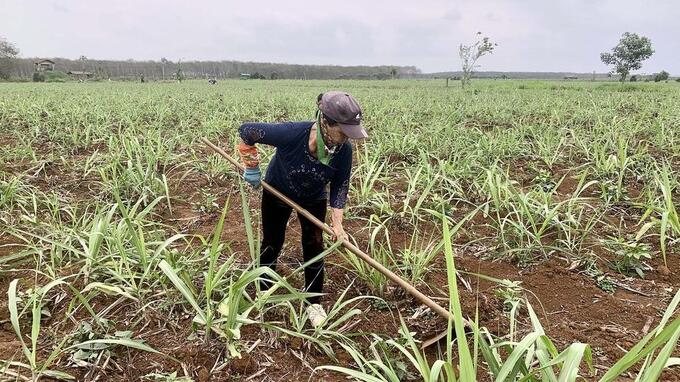
Many rubber patches in Tay Hieu township in Thai Hoa city have been converted into sugar cane by humans. Picture: Phu Huong.
Father: In terms of rubber latex processing technology, most of the agricultural, forestry and rubber tree production plants in Nghe An currently have latex processing plants, but the latex processing technology should be selected. Rubber uggets have finished products RSV 3L, RSV 5L, RSV 10L… although the The investment rate is quite high, but the operating costs are low (only 60% of the costs according to the technology of processing latex from smoke), in addition, the manufactured products have a wide market for consumption.
Four: With regard to agricultural extension, there should be coordination between authorities and units in charge of transferring scientific and technical advances with rubber tree production companies to train and guide growers and processors. Rubber latex producers have mastered the techniques of planting, intensive farming, nurturing and pest control and processing of rubber latex according to the technical process to achieve high latex yield, good product quality and high profitability.
Year: It is necessary to spread to rubber growers who understand and know what they are growing and what they need to raise in the current market mechanism, must always have an aspiration both to ensure high productivity and to achieve good quality from market is accepted, then production will be effective. As long as producers do not focus on investing in intensive agriculture, investing in product quality, but following the market price situation in the short term to develop production, there will be a situation of deforestation and then replanting … always back into the devil’s stuff circle that never succeeds.
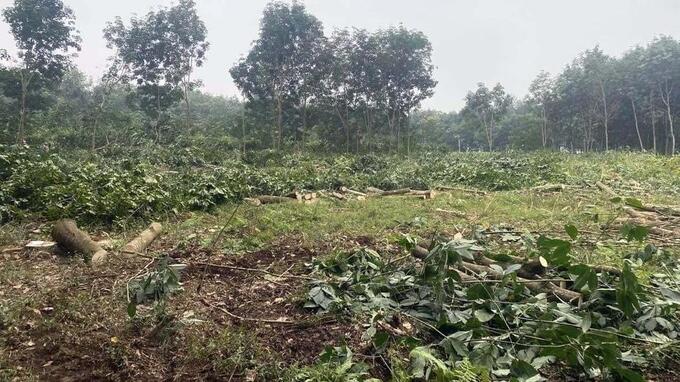
Rubber plantations were cut down by people preparing to switch to other trees. Picture: Phu Huong.
Six: It is suggested that Nghe An Province and related industries such as finance, banking, etc. have mechanisms and guidelines for rubber farmers credit, such as 8th to 15th year, then the rubber tree enters the profitable business stage.
At the same time, support trade promotion to expand the market, build a brand, and introduce Nghe An rubber products to domestic and international consumers through the organization of exhibitions, conferences, seminars and seminars.

